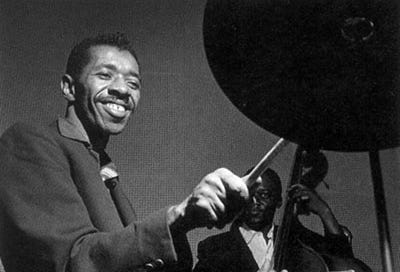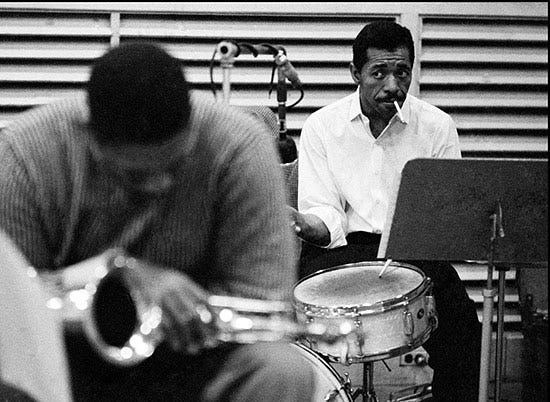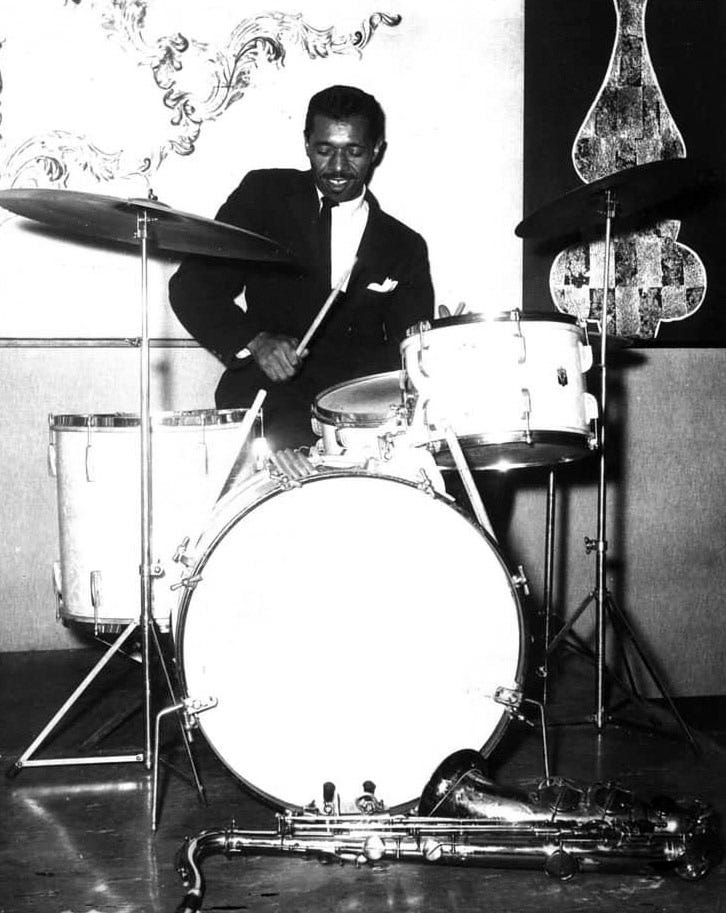Whenever anyone asks me who my favorite drummer is, I have trouble narrowing it down to just one. Several drummers have heavily influenced my taste and drumming over the years. When I was eight years old I wanted to play like Tre Cool so I spent all my time behind the drums playing along to “American Idiot”, “Holiday”, and “Basket Case.” It was all Bonham, Peart, and Moon for a couple of years. Then, it was Lars Ulrich and Joey Jordison. When I was eleven, Max Roach changed my life with his unbelievable drumming on Sonny Rollins’ “St. Thomas” and jazz became a part of my musical world.
That said, Philly Joe Jones (born in Philadelphia on this day in 1923) has influenced and inspired me more than anyone I mentioned above. I remember the first time I heard “Billy Boy” off of the album Milestones. At that time, I was still new to the world of jazz and hadn’t latched onto any drummer too tightly yet. I had heard Max Roach and Buddy Rich but hadn’t done any deep listening or research. I would be understating the impact to say that “Billy Boy” was a light bulb moment.
My whole outlook on the instrument changed and I wanted nothing more than to play like Philly Joe Jones. I wanted my brushwork to be as effortless as his and my time to be as driving as his. As far as soloing goes, I wanted to be able to craft phrases as slick and seamless as his. With a lot of help from my drum mentor, I was able to learn Philly Joe’s “Billy Boy” trades and I was hooked. From Milestones, I moved on to the record that would become my bible: Sonny Clark Trio.
Sonny Clark on piano, Paul Chambers on bass, PJJ on drums, recorded by Rudy Van Gelder in his house/studio in Hackensack, NJ, and my second favorite cover design by Reid Miles. 1957’s Sonny Clark Trio (Blue Note Records LP 1579) is still my most listened-to jazz record. Masterful playing by all three players makes for a piano trio record that is unmatched in energy, virtuosity, and sound. The record’s opener, Dizzy Gillespie’s “Be-Bop”, is a burning masterclass in fluidity, precision, and unwavering intensity. I would eventually learn PJJ’s solo on “Be-Bop” but the first jazz drum solo I ever learned was his solo on “Two Bass Hit”. To this day, I use exact phrases from that solo in my solos. As far as short and sweet solos go, it’s among the very best.
Sonny Clark’s Cool Struttin’ (Blue Note Records LP 1588) is the record that I like to consider the sequel to Sonny Clark Trio. Jackie McLean and Art Farmer join the trio on alto saxophone and trumpet respectively, making for a genuine hard bop supergroup. It’s also the record with my favorite cover art of all time. Philly Joe’s playing on Cool Struttin’ speaks for itself. It seems like every notable jazz drummer has a span of five-ish years where they are untouchable. Philly Joe’s five years were 1958 to 1963. Every record that he appears on within that span features drumming that brings jaws to the floor.
Kelly at Midnite - Wynton Kelly (1960)
No Room For Squares - Hank Mobley (1963)
Workout - Hank Mobley (1961)
Milestones - Miles Davis (1958)
Waiting Game - Tina Brooks (1961)
Showcase - Philly Joe Jones (1959)
Thanks to some tape trickery, Philly Joe plays some beautiful piano on “Gwen”
Hub Cap - Freddie Hubbard (1961)
In New York - Chet Baker (1958)
This isn’t to say that anything that came before or after isn’t worth studying (after all, both John Coltrane’s Blue Train and Lee Morgan’s The Cooker came out in 1957) but for the best of the best of Joe’s playing, 1958 to 1963 is where it’s at.
Two 1956 sessions at Rudy Van Gelder’s studio yielded enough material for four records to finish out Miles Davis’ contract with Prestige Records. These four records would be released over four years beginning in ‘57 with Cookin’ With The Miles Davis Quintet, then Relaxin’ in ‘58, Workin’ in ‘60, and finally Steamin’ in ‘61. The Miles Davis Quintet was composed of Miles on trumpet, John Coltrane on tenor saxophone, Red Garland on piano, Paul Chambers on bass, and Philly Joe on drums. This lineup of musicians made for one of the tightest, busiest, and most-swinging bands in all the land. If Workin’, Cookin’, Steamin’, and Relaxin’ were the only jazz records you had in your collection, you’d be set for life. My personal favorite of the bunch is Relaxin’ but I highly encourage all of you to go check out or revisit these recordings. You’re bound to find something you love. Philly Joe delivers a four-record course on how to play the drums in a band. As I’m writing this piece, I have Steamin’ on my turntable and Joe is in the middle of his otherworldly solo on “Salt Peanuts.”
For some further exploration, go to YouTube and search for Philly Joe. You’ll find some great clips including an hour-long interview. Seeing Philly Joe play is always a delight as he makes everything seem so easy.
Speaking for myself, there’s a pre-PJJ part of my life and a post-PJJ part that’s still being written. There are very few musicians who I can say this for as there are/were very few musicians like Joe. No one sounded like him before and no one has sounded like him since. Happy birthday, Philly Joe Jones. Thank you for everything.






